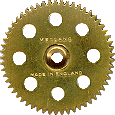Meccano Cleaning & Restoring
_________________________________________________________
(_O__O__O__O__O__O__O__O__MECCANO__O__O__O__O__O__O__O__O_)
Repainting Coloured Parts

Its not necessary to dry parts in an oven if you're not in a hurry.
Wait 12-24 hours before you turn parts over for spraying the backsides.
The paint dries to the same hardness either way, it just takes longer.
To avoid marking painted parts during model construction
two strategies are best:
- Always use a wrench when you tighten bolts!
If you attempt to hold nuts by hand, they will move and remove
paint.
- Use washers under every bolt head and nut.
The type I use are #6 or #8 Stainless Steel.
Brass washers are also available.

Polishing Brass Parts
I use Wenol, a metal polishing compound made in Germany.

Others use Horolene brass cleaner (used by clock restorers) for
tarnished brass - the ammonia fumes will make you gag but the
results are superb. Chemical cleaners must be washed off
thoroughly as they leave a very raw finish that can tarnish again
in seconds if they are not then immediately dried off. A light
coating of spray lacquer can be applied to prevent future
corrosion. Never use steel wool or other abrasives on brass as
they give the parts a very un-natural look. This is especially
important if "restoring" pre-war parts.
Cleaning Zinc Plated Parts
Zinc plated parts often deteriorate fast for a number of
reasons:
- If stored in a Oak chest, the acids released by the Oak will
quickly oxidize the Zinc. Oak is ok for painted parts.
A number of factory-packaged 1970's sets have "self-destructed"
by leaving them in their original oak chests.
-
Poor preparation at the Meccano factory has left some Zinc plated
parts very likely to be covered in
ZnCO3 powdery corrosion.
As this tends to go right through to the steel,
such parts are often not worth restoring.
 An employee of the
Canadian Conservation Institute
(https://www.canada.ca/en/conservation-institute.html)
had the following advice:
An employee of the
Canadian Conservation Institute
(https://www.canada.ca/en/conservation-institute.html)
had the following advice:
Regarding the cleaning of zinc-plated parts: first try a solution of
warm water and dishwashing liquid, followed by a clear water rinse and
thorough towel drying. Avoid acidic or alkaline solutions: both will
attack zinc. Greasy/oily contaminants can be removed with mineral
spirits (Varsol, etc.)
The corrosion on the zinc will probably be either a dark grey oxide
layer - which is compact and protective - or a white powdery layer of
zinc carbonate. Mechanical (i.e. non-chemical) techniques are
recommended to remove both. The gentlest material is a white vinyl
eraser (Staedtler "Mars Plastic" or FaberCastell "Magic Rub"),
available at most stationery stores. To speed things up, you can also
use an electric eraser, made by Koh-I-Noor or Staedtler. There are
about six different grades of eraser strips available. They range from
soft, white vinyl to hard grey, ink erasers. The grey strips are the
most aggressive and are best for removing rust from steel surfaces.
Fine steel wool (#0000) is another possibility, best lubricated with
Three-in-One oil.
Another useful material is a Scotch-Brite (3M) pad, super-fine grade
(grey) or a comparable Norton automotive hand pad (#58002 Micro Fine).
These can be bought at most autobody refinishing supply shops.
To protect the cleaned surfaces and to stop them from tarnishing all
over again, you might consider applying a thin coat of Johnson's Klear
paste wax or Aerowax. Both are stable and easily removed with mineral
spirits. Wax is best applied with clean a cotton cloth (diaper flannel
is best).
Cleaning Nickel Plated Parts
The treatments described for Zinc, especially fine steel
wool, can be used with Nickel.
Re-plating is an option, but it can be pricy.
In theory, you can produce fine results with
an inexpensive "home nickel plating bath".
Rubber
Old tyres should be washed well in warm water and
detergent, followed by a short soak in one of the silicone based
rubber protectants, e.g. Armor-All.
Hardened tyres can supposedly be unhardened using an application of mineral oil
but I haven't tried this myself. You need to wait while the mineral oil is
absorbed into the tyre.
_________________________________________________________
(_O__O__O__O__O__O__O__O__MECCANO__O__O__O__O__O__O__O__O_)

Copyright 1996-2025 by David Williams.




 An employee of the
Canadian Conservation Institute
(
An employee of the
Canadian Conservation Institute
(